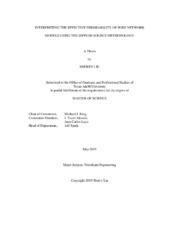| dc.description.abstract | The pore network model obtained from a micro-CT scan of a carbonate outcrop sample has been previously analyzed by former students of the research group for the effective permeability. Analysis techniques included steady state (face), well test derivative and depth of investigation methods. There existed a significant variation in the results from the different methodologies for the same pore network. For example, the results of the carbonate model in the Z-direction ranged from 1,219 md to 36,200 md. The focus of this research work is to find, apply and evaluate alternative methods to explain the large variation seen in the prior methods. Pulse decay and diffuse source approaches were evaluated, where the diffuse source method was eventually chosen due to its ability to capture the range of transient effective transmissibility with respect to time. This method is used in upscaling and modifications are made for its application to the lattice grid. The method is based on a pseudo steady state approach and utilizes the concept of drainage volume. Drainage volume increase with time and the geometry of the increase is based on the diffusive time of flight of each pore within the pore network. The method was applied to both a sandstone and a carbonate pore network. A homogeneous synthetic pore network was created to illustrate the expected differences between the lattice and analytical calculations of the diffuse source method. The comparison of the lattice and analytical solutions for each pore network can indicate the level of heterogeneity within the pore network. As expected, the sandstone model is relatively homogeneous compared to the carbonate model. The variation of permeability values previously calculated is explained as a transient effect. On top of describing the internal heterogeneity, the method can also indicate the level of anisotropy due to the direction of flow. Finally, we are able to visualize the drainage pattern and the sub volumes that contribute to the transient transmissibility calculation. | en |


